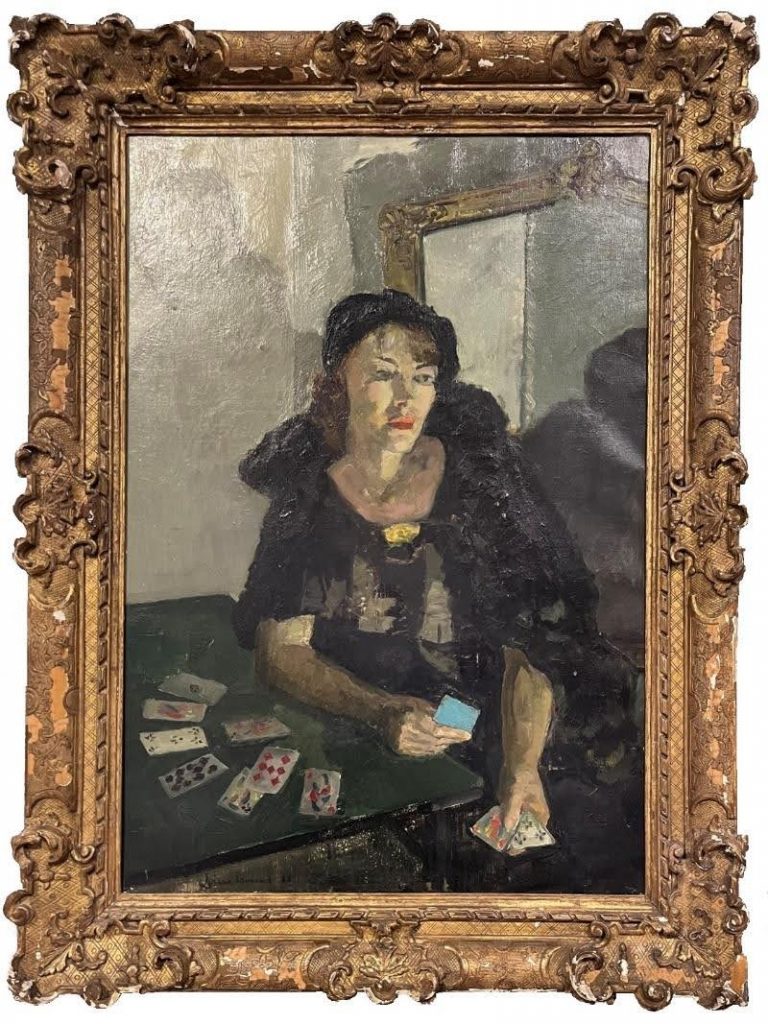Collection close-up: ‘La Femme avec Carte’
By Elizabeth Coulter, former curator of collections for the Delaware Division of Historical and Cultural Affairs
New research has uncovered the history of a painting that was once plundered by Nazis in WWII and that is now held in the State of Delaware’s museum collection.
The history of this 1936 painting by 20th-century Parisian artist Diane Esmond (1910-1981) wasn’t uncovered until recently, thanks to curatorial research.

An article, “What happened to the collection of Edouard Esmond?,” published in 2020 by Marc Masurovsky, a co-founder of the Holocaust Art Restitution Project (HARP, revealed the prewar art career of Esmond, noting that “La Femme avec Carte” (which translates to “The Woman with the Card”) was a missing painting. In 1941, the Einsatzstab Reichsleiter Rosenberg (ERR), a special task force involved in the plunder of cultural property, had looted personal property from the Esmond family home, including many of Diane Esmond’s early paintings after she and her family escaped German occupation in France.
The Database of Art Objects at the Jeu de Paume, which is a searchable, illustrated database that contains information on more than 40,000 art objects looted from Jews in German-occupied France, holds documentation of Esmond’s art, including the painting found in the collection at the Delaware Division of Historical and Cultural Affairs. This information was undiscovered by the artist’s descendants and most of the world, including the State of Delaware, until recently after Masurovsky published his research.
The Database of Art Objects at the Jeu de Paume notes the painting as “restituted,” and the collections team conducted further research to determine the movement of the painting after 1944. The collections team connected with Esmond’s living descendants who confirmed the painting returned to the family after World War II. After that, their family friend became the owner of the painting, and they donated the painting to the State of Delaware in the 1960s.
Though there are few examples of Diane Esmond’s prewar work today, she painted colorful, thoughtful compositions her whole life. This painting is the first of her works in a museum collection.
“La Femme avec Carte” features a moody, intentional color palette, an expressive, painterly style, balanced composition, and dramatic light contrast. Together, these elements create movement and visual intrigue that shape the tone of the painting and its narrative. The woman is central in the composition, her gaze directed to something outside the frame. She rests her right arm on a green table while holding a blue card that faces toward herself, and her left arm rests on her lap revealing two playing cards. Behind her left side is a mirror that reflects the back of her body and behind her right side is a dramatic shadow of her silhouette.
Most of the scene is represented in the foreground of the painting, while the background has less detail, creating a sense of balance. There also is cohesion in the color palette: Most of the colors are muted with green undertones, though there are pops of color that direct the viewer’s eye to the main components of the portrait. Her lips are an orange-red color, her dress has a yellow design element, and the card is bright blue. This line of bright, primary colors creates contrast and invites the viewer to look back and forth between the woman’s face and the cards in her hand. Her face and hands are also emphasized by the lines and light of the composition. The lines of the mirror and the table point to her face and hands. The light coming from the lower righthand side of the painting acts as a spotlight on the brightest parts of the composition, which are her face and hands. The thoughtful approach to composition and design creates a sense of drama and makes the viewer observe in anticipation of the woman with the card’s next move.

As the Delaware Division of Historical and Cultural Affairs’ former curator of collections, Elizabeth Coulter participated in developing and installing exhibitions, developing and presenting educational programs, providing access to the collections, collaborating with partnering organizations and expanding the profile and use of the collections. She holds a bachelor’s degree in art history and American studies from Rutgers University and a master’s degree in decorative arts history from George Mason University and the Smithsonian Associates.


